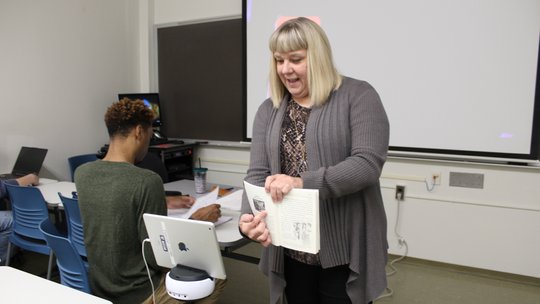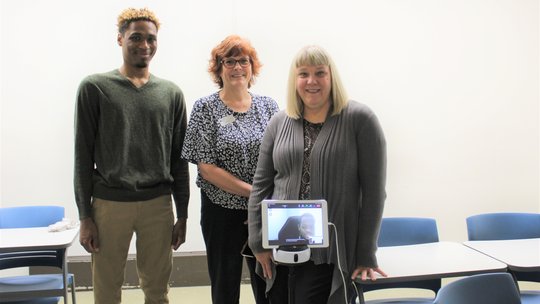
The coronavirus pandemic forced educational institutions to quickly rethink course delivery options. In doing so, most opted to offer virtual classes and implement technology in innovative ways to ensure student success.
By broadening the use of Swivl technology to include students with disabilities, St. Louis Community College-Florissant Valley created a welcome learning option for Sean Gold. This project was a finalist for the St. Louis Community College Innovation of the Year Award.
Swivl is an innovative video capture system that can be used to record lectures and facilitate virtual discussions or class meetings. It is a robotic mount for an iPad, camera or smartphone that comes with a remote-controlled marker. It is designed to track and record videos of a moving person who is wearing the marker.
For Gold, who now attends the University of Missouri-St. Louis, Swivl provided a means to take live classes virtually. Gold’s physical disability is cerebral palsy; he has a tracheostomy breathing tube that prevents him from speaking as well as attending classes in person.
Florissant Valley’s Access office has implemented Swivl technology for various applications over the past several years. When in-person classes resumed, Access staff wanted to extend Swivl’s use to provide remote learning opportunities in cases like Gold’s.
“Online learning is fundamentally different from classroom learning,” said Amy Bird, director of the Access office at Florissant Valley. “We wanted to provide a way for Sean, who cannot physically speak, to participate without compromising the classroom experience and without creating additional burdens for the faculty. The live virtual learning options that were developed during COVID demonstrated that colleges could present information remotely and have a more inclusive classroom. Swivl gives us another tool to enhance remote learning.”
Kelly Mueller, associate professor of Spanish at Florissant Valley, at first was reluctant to return to the virtual world of teaching. Gold’s situation changed that.

“I was intimidated to have to face technology again,” Mueller admitted. “However, providing this opportunity so that one of my students could continue their study of Spanish because they love it? I was all in.”
The Access office hired Myles Hinton, an educational assistant, to be the in-class support for Gold and Mueller. Prior to class, Mueller sent worksheets via email to Gold. Hinton set up the tripod an iPad in the classroom and put the tracking device in Mueller’s necklace, as well as ensured connection to Gold’s Zoom room at home. The iPad rotated wherever Mueller moved in the classroom. If Gold had a question or comment, he raised his hand and sent a message to Myles. Mueller responded to the message, which benefited everyone in the classroom. When the class worked in groups, Hinton moved the tripod to allow Gold to participate in that group’s activities.
If it weren’t for Swivl, Gold said he would not have been able to complete the last two classes he needed to graduate from STLCC and transfer to UMSL.
“The biggest thing that disabled people want is independence,” he said. “Having the option to be in class virtually, not just by online forums, is disability justice. I don’t have to rely on my family to drive me to and from classes, which takes away from their work time. Although I am at home, Swivl creates more of a classroom feeling than to be on a Zoom call in real time with my peers. I think that my use of Swivl and technology has helped to make more people aware of the needs of people with disabilities. My professor (Mueller) was amazing and was always willing to learn how to make everything accessible for everyone.”
The once-reluctant Mueller now embraces the technology that helps makes her a better teacher and helps her students achieve their goals.
“COVID was a challenging situation for all of us but has opened our eyes to the possibilities available to support students,” Mueller said. “I am thankful to the Access office for leading this project and for guiding me. Because of their creativity and efforts, distance will never stop education.”
Learn more at stlcc.edu.
St. Louis Community College has served more than 1.3 million students since 1962. More than 50% of households in the area are represented by our former and current students. STLCC firmly believes that education has the power to lift us up — as individuals, as communities and as a city.



